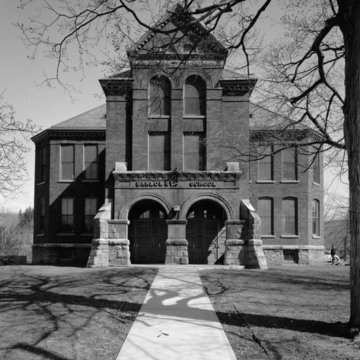Among the great prides of the new City of St. Albans were its twin schools constructed in the civic building campaign of 1897. The hipped-roof, brick and stone, two-and-a-half-story schools were built for the first through fourth grades. They are T-shaped in plan with entrance in the leg of the T, where symmetrical flights of stairs feed broad central halls that give access to two large classrooms per floor. Tall windows with cast-iron sills flood the spaces with light. Civic pride pushed the buildings beyond mere utility, with particular care lavished upon the entrance pavilions. Here, rock-faced granite foundations rise through piers and angled corner buttresses to support the twin Romanesque arches of an entrance porch. Round arches are repeated in paired third-floor and attic windows in the narrowed and gabled central bay that rises above the porch. A metal foliate frieze and a dentiled metal cornice similar to those on the city hall crown each building. Bowing to changing school patterns, both schools were closed in 1970, but they have since found continued public use, the Messenger school as a senior center and the Barlow school as a youth center.
You are here
Messenger and Barlow Street Schools
If SAH Archipedia has been useful to you, please consider supporting it.
SAH Archipedia tells the story of the United States through its buildings, landscapes, and cities. This freely available resource empowers the public with authoritative knowledge that deepens their understanding and appreciation of the built environment. But the Society of Architectural Historians, which created SAH Archipedia with University of Virginia Press, needs your support to maintain the high-caliber research, writing, photography, cartography, editing, design, and programming that make SAH Archipedia a trusted online resource available to all who value the history of place, heritage tourism, and learning.


